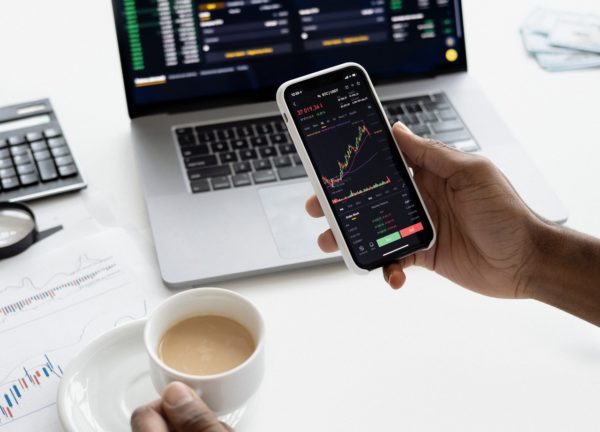By Claire Ballentine and Charlie Wells
When Bitcoin plunged in September, El Salvador’s President Nayib Bukele tweeted a version of the three words that have become a mantra for meme stock traders: Buy the dip.
This past year, those three words have ricocheted across social media any time a meme asset slumps. AMC shares in freefall? “Buy the dip,” Redditors insist. Crypto taking a slide? Cue a flock of “buy the dip” tweets. A celebrity SPAC is spiraling downward? Telegram groups alight with prods from hopeful buyers.

It’s not a new concept: When others panic and sell, pushing the price down, bullish investors say it’s a good time to pick up shares on the cheap. The phrase has become a go-to rallying cry during volatile pandemic times — particularly during weeks like this one when Bitcoin, for instance, sank as much as 17% in a matter of minutes. That was its lowest level in a month.
It requires a level of faith that the asset, whatever it is, will revert to a higher level.
“Markets have gone up for so long now and people have made so much money, and retail investors don’t want to be left out of this momentum,” said Sara Rajo-Miller, an investment advisor at Miracle Mile Advisors. “There’s this sense of community with Twitter and social media where we can inform each other. We’ve literally seen that drive stock prices up in certain cases.”
El Salvador became the first country to adopt Bitcoin as legal tender. That was expected to be a potential turning point in the crypto asset going mainstream. But instead of going up, Bitcoin dipped. It fell to as low as $43,050.
That’s when Bukele employed the phrase. “Buying the dip,” he tweeted, with a winky face emoji.
He said the country brought its total Bitcoin holdings to 550, which is worth around $25 million of the cryptocurrency, though that changes from minute to minute, of course. The volatility was validation to those who said that Bitcoin shouldn’t be used as a currency.
Ashley Duncan, for one, is sick of it.
The 29-year-old retail investor from Dallas says she is a “gambler at heart” who has made several thousand dollars in the crypto space. But after a seeing the price of Bitcoin, Ethereum, Dogecoin and other meme assets slump over the past few months, Duncan said she now vows to “hodl for dear life.” (Hodl — internet-speak for holding an investment long term.)
Part of her perspective comes from a $2,000 loss on a cryptocurrency token called “Trustworthy and Reliable Intelligent Autonomous Systems” (or Trias for short). She bought in May when the token was dipping from a high of over $30. She went in at $19 but has seen the dip continue dipping. Trias now fetches less than $9 or so on the market.
Duncan feels like a lot of “buy the dip” chatter is just hype that ignores a crucial reality of investing: “With any investment, it’s an unsure thing,” she says. “You can’t keep giving all your money and making yourself fiat broke for a future that’s risky.”
Don’t expect to hear opinions like that on social media often. It’s easy to talk publicly about making money or to tell people that a stock is going to surge (even if it won’t). It’s a lot harder to talk about losing money.
In light of all the “buy the dip” hype, gains and losses this year, two professors wanted to know if the strategy helps or harms investors.
So Thomas Shohfi from the Rensselaer Polytechnic Institute and Majeed Simaan from the Stevens Institute of Technology researched two different investment cases — an investor who has a lump sum that will be invested over time, and one who receives a fixed amount of cash each month to invest. They simulated how each strategy would “buy the dip” with four different starting periods: two during bull market beginnings in January 1994 and January 2010, and two at the start of bear markets in January 2000 and January 2008.
What they found in a paper published this year was that buying dips can help improve traders’ risk-adjusted return — or the profit an investment generates over a specific period in comparison to the risk involved — but not necessarily their wealth over time. What’s more, the strategy can help an investor manage the market’s ups and downs, but it comes with a tradeoff — cash sitting on the sidelines waiting to be invested in those drops. During the time that money is not invested in the market, it’s not growing since interest rates are near zero.
“There’s always an opportunity cost,” Simaan said. “The fact that you’re sitting on the side, you’re missing that opportunity.”
If buying the dip serves as a reminder for investors to put cash in the market on a regular basis, that could help them in the long run, since the stock market reliably trends higher over time. The key is to not deploy too much money at once and to be cognizant that certain drops can continue longer than expected.
“If you buy the dip and it goes down and you buy the dip and it goes down and you get frustrated because you don’t catch the bottom — you say, why am I doing this, I keep losing more money,” Shohfi said.
To Dan Egan, managing director of behavioral finance and investing for robo-adviser Betterment, the idea of buying the dip can make new investors feel more confident putting their money in the market.
“If it’s what gets people comfortable with investing, go ahead and do it. But my concern is that if there is ever a dip that is a trough, people might feel like I bought the dip and it kept dipping, maybe buying the dip isn’t as good as you say,” he said. “But there is camaraderie in buying the dip.”
For an example of how buying the dip can boost — or burden — returns, take a look at Cathie Wood’s ARK Innovation ETF (ARKK). If you had purchased shares of ARKK during the March 2020 plunge and held onto those until now, they would be worth about 250% more. But say you heard the hype around Wood and her success in mid-February 2021 and decided to buy in. You’d now be sitting on a 20% decline.
Now consider if you saw ARKK’s price falling from its all-time high in mid-February and tried to buy the dip on Feb. 22. It turns out that slump had further to go — those shares would now be worth about 13% less.
It’s all about timing for Bitcoin, too. If you’d bought during the mid-January slump, your holdings would’ve risen more than 100% by April — before falling 40% by the beginning of August.
But if you bought during the cryptocurrency’s slump on July 20, those holdings would’ve made double-digit gains.
“The probability of success ebbs and flows,” said Scott Knapp, chief market strategist at CUNA Mutual Group. “There’s so much uncertainty associated with the buy-the-dip strategy. It’s really the conditions at the time that set the odds.”
More stories like this are available on bloomberg.com.




